1. Jesus Turned the Water into Wine
Read John 2:1-11
Do you find it interesting that Jesus chose to reveal His glory first at a wedding? Weddings are joyful and blessed occasions now, but even more so in Israel during the time of Christ. What a sweet way to remind believers of His ultimate purpose of redeeming His bride, the church, to Himself. (Ephesians 5:22-33)
This is certainly no coincidence as John also refers to Christ as the bridegroom in John 3:25-30, and in John’s final book of Revelation, he says all believers will one day celebrate the Marriage Supper of the Lamb. Jesus often used the analogy of a wedding feast throughout His parables found in the other gospel accounts. In John 14, we also find Him comforting His disciples with this same marriage language. He promises to go and prepare a place for them within His Father’s house, which they would have all immediately recognized as the common practice of a groom preparing a room or rooms within his own family’s home in preparation for His bride.
During the time of Christ, a wedding lasted seven days, and the host invited as many people as possible, especially distinguished guests like prominent teachers. This was a prestigious celebration and wine was an integral part. Wine is often used throughout Scripture (both Old and New Testaments) to represent happiness and fulness and abundance. And, as the host of this wedding feast, the bridegroom wanted to be sure that there would be plenty of wine to last the entire week. To run out of wine at a wedding was a social disaster that would become the subject of jests for years. It would imply that the groom was incapable of providing for his new bride. Worst of all, it might also be interpreted as God’s blessing being withheld.
It seems that Mary, Jesus’ mother, was close to the host family as she was aware of the problem. She immediately went to Jesus for help. Jesus’ response might come across to us as rude to modern-day hearers. However, we need to consider the message behind His words as well as what follows this response.
Jesus addresses Mary in a way that could abruptly arrest her (and us) to the fact that He is here on a mission, and that even though Mary is His earthly mother, Jesus’ ultimate goal is to redeem sinful Mary along with the rest of sinful humanity. Whenever Jesus’ “Hour” is used in John’s Gospel it is referencing the event of the CROSS. So, Jesus is likely indicating to Mary this: “Once I begin doing miracles, I begin the road to the CROSS.”
While Mary didn’t grasp the significance of the statement, John records it for us with the clarity of hindsight. Regardless, Mary fully expected Jesus to come to her aid. While I’m sure she didn’t know what He would do, she believed that He was the only one who could do something, so she instructed the servants to immediately do whatever He told them.
The result of this miracle is two-fold. First, Jesus prevented shame. Secondly, He provided deep joy. Jesus didn’t simply ensure that the wedding party had enough wine to avoid humiliation. He created something far better than anything they had ever had surprising the master of ceremonies.
This first sign points to Jesus who alone can remove the shame and guilt of your sin and give you true joy that far surpasses anything found in this world. John makes this purpose very clear by placing John the Baptist’s testimony about Christ as the Lamb of God in the chapter before this sign is given and telling us that the Passover was at hand directly after the miracle happened.
“Behold, the Lamb of God who takes away the sins of the world.”
Study it Out
- Read Exodus 12 to refresh your memory about why the Jews celebrated Passover faithfully each year. Then, read Luke 22:14-20 as Jesus tells his disciples to partake in the bread and wine, pictures of his body and blood about to be broken and spilled for them.
- John’s gospel was written well after the other three gospels, so the practice of the Lord’s Supper was well established. Make note of the specific conversations John chooses to emphasize found in John 13-16. What references to wine or the fruit of the vine are mentioned here? How are love and joy emphasized in these passages as well as familial references? How does this focus tie into the first miracle as well as John’s emphasis throughout his gospel?
- Note the example of the prodigal son’s father in Luke 15. How do you see shame being absorbed and joy provided in this parable? How does it relate to Christ’s response to your sin and shame?
- Read John 3:25-20. What fruit of the spirit is mentioned in this passage? Where is true joy found according to Psalm 16:11?
- Read Luke 5:33-39. How does this first miracle put context to the illustration of new and old wine given in Luke’s gospel? Think about the audience to whom Jesus was speaking? Why were the Pharisees clinging to the “old wine” rather than accepting the new wine Jesus was offering? Have you tasted Christ and found Him to be far superior to anything else this world can offer?
- Speaking of the old covenant of the law, let’s consider Moses for a moment. What was Moses’ first sign to the Egyptians found in Exodus 7? This sign brought death. What did Jesus’ sign bring? Read Romans 6-7 for a fuller context of the law’s purpose and place along with Jesus’ superiority and victory over sin and death.
Listen
Listen to the original sermon by Bob Roberts for juniors. The PowerPoint file below corresponds to the audio file, and this sermon is geared to juniors aged 9-12.

